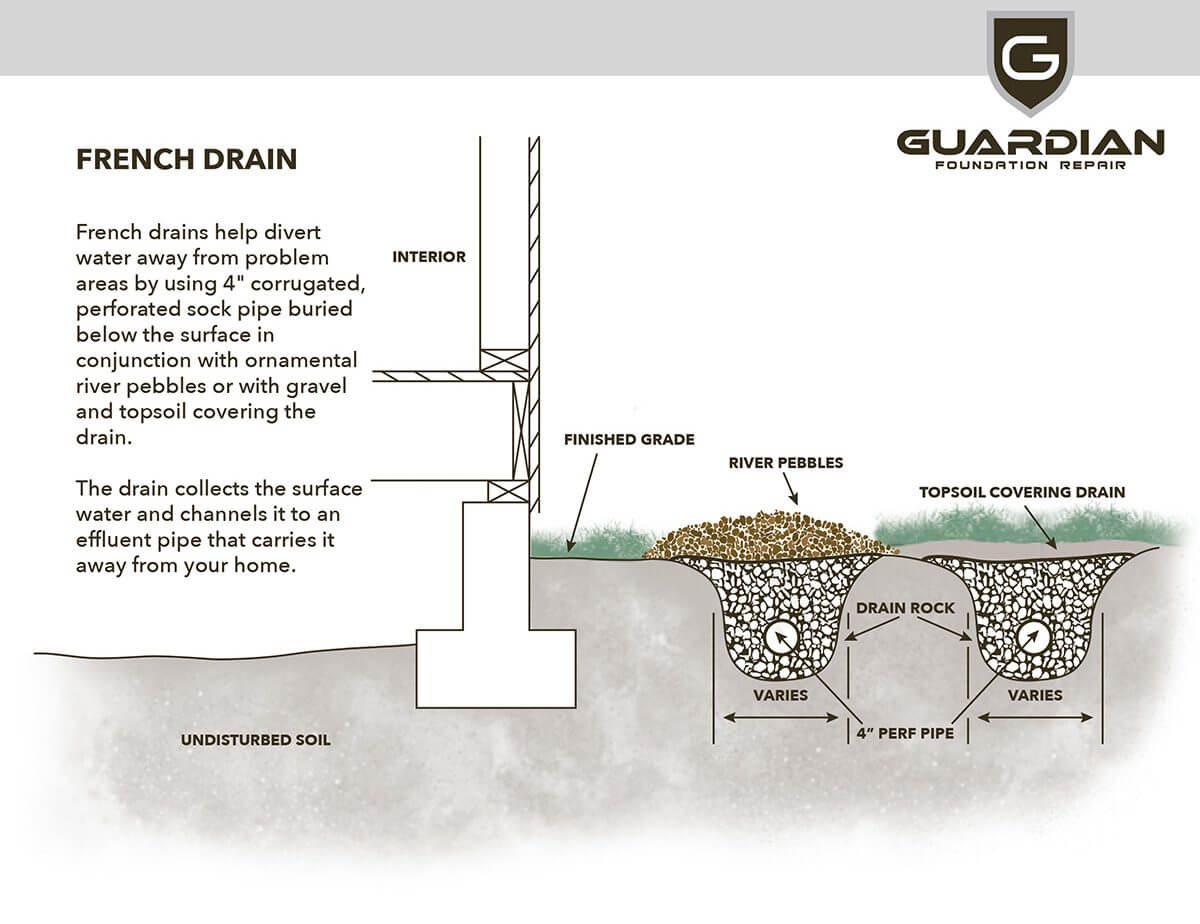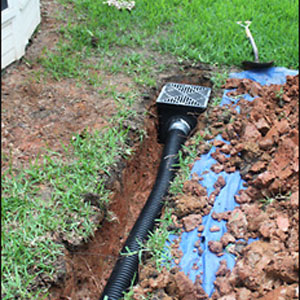Comprehensive Solutions for Efficient French Drain Setup
When it involves managing water drain on your property, recognizing the duty of a French drainpipe is necessary. You could assume it's simply digging a trench and laying some pipeline, yet there's far more to it. Appropriate assessment and setup can make all the distinction in stopping water damages. Curious regarding what actions you should require to guarantee an effective installment? Let's check out the vital components and procedures entailed.
Comprehending the Purpose of French Drains
When it involves managing excess water around your building, understanding the objective of French drains is essentially crucial. These drainage systems successfully reroute water away from your structure, lowering the danger of flooding and wetness damages. Essentially, French drains consist of a trench full of gravel or rock, housing a perforated pipeline that gathers and networks water.
Examining Your Building's Water drainage Demands
To examine your building's drainage requirements, beginning by recognizing locations where water often tends to build up. Next, assess the quality of your soil drainage, as it plays an important role in managing water circulation. By recognizing these aspects, you can make enlightened choices concerning mounting a French drainpipe.
Recognizing Water Buildup Locations
Identifying water build-up areas on your residential property is necessary for reliable drain options. Begin by walking your lawn after heavy rainfall or snowmelt. Seek puddles, soaked areas, or locations where the lawn shows up greener and lusher than the bordering areas-- these signs show persistent water build-up. Take note of low-lying sections, as they frequently collect water. Observe how runoff acts throughout tornados; does water flow towards your structure or other vital locations? Notification any type of locations where downspouts direct water, as inappropriate drain can aggravate problems. By determining these accumulation sites, you can much better establish where to set up French drains pipes, ensuring they work properly and safeguard your property from water damage.
Assessing Dirt Drain Quality
After determining areas where water tends to build up, the following action involves examining the soil drainage quality on your home. To do this, you can execute a simple drain examination. Dig a hole about 12 inches deep and load it with water. Observe exactly how promptly the water drains. Your dirt has excellent drain if it vanishes within a few hours. If it takes even more than a day, you could have clay-heavy dirt that retains water. Furthermore, think about the soil texture; sandy soils usually drain pipes well, while silty or clay soils might create problems. Understanding your soil drain quality aids you identify the best remedies for efficient French drainpipe setup, guaranteeing your property continues to be dry and well-managed.
Secret Components of a French Drain System
To develop an efficient French drainpipe system, you'll need to concentrate on a few vital elements. Picking the best drainage pipe, making use of gravel and filter material, and guaranteeing appropriate slope setup are essential actions. Each element plays a crucial function in routing water away from your property successfully.
Drain Pipeline Choice
When selecting drain pipelines for your French drainpipe system, it's important to evaluate the product and diameter that ideal suits your certain requirements. PVC pipes are preferred because of their sturdiness and resistance to deterioration, while corrugated plastic pipes use flexibility and convenience of setup. Take into consideration a diameter of at the very least 4 inches to effectively manage water flow, yet assess your website's drainage needs to identify if a larger dimension is needed. You'll additionally intend to guarantee the pipeline has sufficient perforations to enable water access while preventing dirt obstructing. Ultimately, selecting the appropriate drainage pipe will certainly boost your French drainpipe's total capability, keeping your building free from undesirable water build-up.
Crushed Rock and Filter Fabric
Crushed rock and filter fabric are essential elements of a well-functioning French drain system. The crushed rock serves as a water drainage tool, allowing water to move easily while avoiding dirt from blocking the system. You'll intend to pick tidy, smashed rock or crushed rock, as it offers excellent water drainage and sustains the pipe effectively.
Filter material, on the other hand, plays an important duty in maintaining debris out of the gravel layer. By wrapping it around the drainage pipe, you create an obstacle that lets water travel through while blocking dirt and particles. Together, these products ensure your French drainpipe runs successfully, avoiding water buildup and shielding your building from potential damages. Correct selection and installment of gravel and filter material are vital to lasting outcomes. Ft Worth French Drain Installation.
Appropriate Incline Installation
Accomplishing the correct incline in your French drain is crucial for reliable water monitoring. A slope of at the very least 1%-- that's a decline of one inch for every single 10 feet-- makes certain water moves successfully towards the drainpipe outlet. To start, mark your intended incline along the trench making use of risks and a string line. As you dig, routinely check the depth to keep the right incline. It is very important to avoid low places where water can merge, so keep your trench consistent. Backfill with gravel to protect against and sustain the drain soil from obstructing the explanation system when you've achieved the appropriate incline. Appropriate slope setup not only improves drain but also expands the life expectancy of your French drainpipe.
The Installation Process: Step-by-Step
To guarantee effective water drainage around your property, comprehending the setup process of a French drainpipe is necessary. You'll require to pick the right location, ideally where water collects. Next off, mark the area and dig a trench concerning 18-24 inches deep and 12 inches wide, guaranteeing it has a regular slope away from your structure.
As soon as you've prepared the trench, lay down a landscape textile to prevent soil from clogging the drain. Location the perforated pipe on top of the crushed rock, making certain the openings encounter down.
Finally, fold the landscape fabric over the gravel, then fill up the trench with soil - Ft Worth recommended you read French Drain Installation. Condense the dirt gently, and you're done! Enjoy comfort knowing your residential or commercial property is protected from water damage
Keeping Your French Drain for Long Life
After you've mounted your French drainpipe, preserving it is crucial to its durability and performance. Normal evaluations are necessary; look for any debris or debris buildup that could block water flow. Clear any type of fallen leaves, dust, or various other products that may build up at the surface or around the drainpipe's openings.
It's also important to check the water drainage efficiency during heavy rains. It might suggest an obstruction that needs instant interest if water pools near the drainpipe. In addition, ensure the surrounding landscaping does not hinder the drain's function-- origins can attack and block the system.
Take into consideration scheduling professional examinations yearly. Specialists can identify prospective problems you might forget. Keep an eye on the overall landscape rating to ensure it routes water away from your foundation. By taking these actions, you'll ensure your French drainpipe remains to perform properly for many years ahead.
Usual Mistakes to Prevent During Setup
Also though installing a French drainpipe can appear simple, many home owners make important mistakes that can jeopardize its effectiveness. One typical error is not digging the trench deep sufficient. If the drain isn't put listed below the frost line, it might freeze, rendering it useless during wintertime.
One more blunder is failing to keep a correct slope. Your drainpipe ought to slope at the very least 1% to guarantee water moves towards the outlet. Disregarding to utilize the right products can also bring about problems; always select perforated pipeline and crushed rock for peak drainage.
Furthermore, ignoring the relevance of correct outlet placement can trigger water to back up. By preventing these errors, you'll boost the performance of your French drainpipe.
Why Work With Specialists for French Drain Setup
Setting up a French drainpipe could appear like a DIY task, yet the complexities entailed can make it a lot more difficult than you think. Specialists bring proficiency that assures the drainpipe is placed in the right area, at the appropriate depth, and with correct grading. They understand the regional soil conditions and can pick the most effective materials, which conserves you from expensive mistakes.
Moreover, employing experts suggests you'll prevent the physical pressure of digging trenches and handling hefty materials. They also have the right devices and tools to finish the job successfully and securely.
In addition, expert installation usually features warranties, offering you satisfaction. You'll have assistance to treat it if a concern develops later on. Eventually, buying experts for your French drain installation guarantees your residential or commercial property stays safe from water damages while saving you time and initiative over time.
Regularly Asked Questions
Exactly how Much Does It Typically Expense to Install a French Drainpipe?
Usually, you'll locate French drain installation expenses vary between $1,000 and $6,000, depending on variables like the project's size and complexity. It's ideal to get numerous quotes for the most accurate price quote.
Can I Set Up a French Drain Myself?
Yes, you can set up a French drainpipe yourself if you have the visit site right devices and knowledge. Nevertheless, it requires cautious planning and execution to guarantee appropriate water drainage and avoid future problems, so be prepared.
What Sorts Of Soil Job Best for French Drainpipes?

For how long Does a French Drain Installation Take?
A French drain installation generally takes one to three days, depending on the site's conditions and complexity. You'll desire to plan for excavation and water drainage job, making certain every little thing's collection for a smooth procedure.
Will a French Drainpipe Prevent Flooding Totally?
A French drain won't totally avoid flooding, however it substantially reduces water accumulation. It channels excess water away, assisting secure your home throughout heavy rain. When you need it most., normal upkeep guarantees it functions efficiently.
Final thought
In summary, understanding and applying a substantial French drain system is crucial for efficient water monitoring on your residential property. By assessing your water drainage requires, knowing the parts, and following a correct setup procedure, you can protect your home from prospective water damages.

Together, these materials assure your French drain runs successfully, avoiding water accumulation and protecting your residential property from possible damage.To ensure reliable water drainage around your home, recognizing the installation process of a French drainpipe is crucial. Eventually, investing in specialists for your French drain installation assurances your building continues to be safe from water damage while saving you time and effort in the long run.